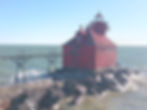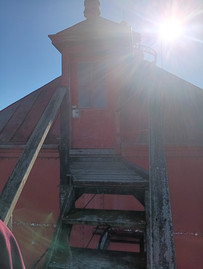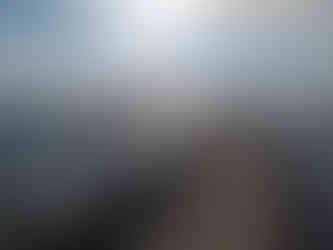A Rare Look Inside the Sturgeon Bay North Pierhead Lighthouse
- Jake Heffernan
- 5 days ago
- 8 min read

The iconic red Sturgeon Bay North Pierhead Lighthouse, marking the entrance of the Sturgeon Bay Ship Canal has new owners! Jeff and Donna Feuerstein don't have a long commute to get out to their "new" lighthouse - their house is right at the base of the pier the lighthouse sits on. Their driveway is actually shared with Coast Guard Station Sturgeon Bay immediately to the south. Jeff commented the Coast Guard are very good neighbors to have. The men and women assigned there often offer to mow his lawn or shovel his driveway, just for a little extra work to keep them occupied.

Jeff invited Jake Heffernan of the Kewaunee Lighthouse out to see the interior of the Sturgeon Bay lighthouse and get some input on a few questions he had about the lighthouse and his plans for it. He graciously showed Jake his and his wife's historic home - which is actually 3 years older than the current lighthouse - before climbing the ladder to the catwalk and making the 1,000 foot journey above the pier to the lighthouse.
On this blustery October day, the need for the catwalk was apparent with waves breaking on the riprap around the pier and sufficiently wetting the surface of the pier. On the catwalk, we were high and dry. Jeff says that during some storms however, the waves will break at pier level and spray high above the catwalk, drenching everything in frigid lake water.
The Feuersteins are not the first private individuals to own this little red lighthouse. When no non profit organizations came forward to claim the lighthouse after it was declared government surplus, Gordon Krist of Kentucky won the subsequent 2014 auction with a winning bid of $48,500. Jeff said he got to know Mr. Krist well over the past 11 years. Jeff asked Gordon several years ago to keep him in mind if he ever wanted to sell the lighthouse. Gordon replied he'd never want to sell, and hoped to keep the lighthouse in his family. By a sudden twist of fate, Jeff was recently offered to purchase the lighthouse from Gordon, and he and his wife jumped at the chance to own this piece of history.

Upon entering through the upper level door, we found ourselves in an open room with sloped ceilings, similar to an upper half story of a house. The ceilings and walls were clad in beautiful, white pressed tin. On our left was the stairway down to the former coal bunker and main level machinery space, and straight ahead was the circular tower rising up from the lakeward side of the lighthouse. The interior of the room had 2 large pipes extending from floor to ceiling. One was the original chimney for the boilers, the other was a vent pipe for the machinery space. Walking through the tower door and into the cylindrical watch room, a vertical ladder leads to the lantern above, and two director-style chairs sit side by side, ready to allow one or two to look out the portholes and out towards the expanse of Lake Michigan beyond.
Climbing the ladder, we see the lighthouse is lit by a 2-tier LED light that's programmed to emit a red flash. The LED light sits on the original pedestal which once supported the 6th order Fresnel lens, later replaced with a slightly larger fifth order lens. An interesting feature from the past, is the fact that the diaphone fog horns were mounted inside the lantern, with the resonators passing through the steel wall and out to the gallery railing. Now, two metal discs mark the location where the thundering horns passed outside to grunt their warning to approaching ships. A short segment of the 4" diameter air supply pipe still exists at the ceiling of the watch room ending with a flange on the floor of the lantern above.
Back out of the tower, we headed downstairs to the pier level. When it was built, the Sturgeon Bay Lighthouse had a 10" diameter steam whistle as its fog signal. To supply the steam, the 1st floor was originally split into two spaces - the boiler room on the lakeward 2/3 of the building, and the coal bunker nearest to shore. Looking at building plans, when the building was modified and the boilers replaced with air compressors, the staircase was moved from the boiler room to the coal bunker, where it is now, and several other rooms were built. One room housed the transmitting equipment for the new Radio Beacon - the lighthouse, the Kewaunee Lighthouse, and Gray's Reef Lighthouse were the first 3 stations on Lake Michigan to receive the new technology in 1930. Another room housed the toilet. The boiler room then received air compressors and a backup generator.
Today, Jeff and Donna use the old radio transmitter room for storage. The door is still stenciled with its purpose, with very little peeling paint. It gives the appearance that a Coastguardsman might enter the lighthouse at any moment to begin his shift to activate the radio beacon and fog signal compressors.
The old bathroom now features a composting toilet - a far more responsible solution when compared to the direct-to-lake toilet, as was very common in the Coast Guard and Lighthouse Service eras.
The largest room in the former coal bunker is now a bedroom. The hatch in the roof that used to load the coal into the bunker still exists, and Jeff hopes to get to a point where it can open again for light and ventilation, with the further hope of fitting it with a screen to keep bugs out.
The former machinery space is now living space with couches, a kitchenette, and dining room table. Shadows of the room's former uses still remain - the chimney that once carried coal smoke out of the boilers is still in the center of the room. The massive steel doors that once brought supplies into the lighthouse on the protected side still look as though they could open - although they were welded shut years ago. The exhaust pipe for the gasoline air compressor still hangs from the ceiling, as does the 4" air pipe for the diaphones. A large manhole cover near the kitchenette hides the well which once provided water out of the lake for use inside the building.
The space reminds me somewhat of an apartment created in a former warehouse or manufacturing space. It's a unique blend of homey and industrial.
What's the goal, you may wonder? And why is it set up as living space inside and not "historically accurate?"
Well, the goal is to eventually allow public visitors into the lighthouse on occasion, especially during the Door County Maritime Museum lighthouse weekends. Jeff loves history and is excited to share it with the people he knows have been admiring this lighthouse for many years. He envisions historic displays on the 2nd floor as one enters from the catwalk which will tell the story of the station's history as well as the changes its undergone over its 120+ years of service. Unfortunately, the journey out to visit the lighthouse may not be for everyone - the catwalk is accessed by a vertical ladder, as is the lantern atop the tower. Jeff and Jake brainstormed some possibilities to make access to the catwalk a bit easier but those possible solutions are likely not near in the future.
As for the decision to create living space as opposed to museum space downstairs, Jeff doesn't desire a museum. We have pier lighthouses set up as museums elsewhere, such as Kewaunee and Manitowoc, along with several more on the Michigan side of the lake. Like other pierhead lights, this lighthouse was never lived in. The keepers who worked here lived on shore and only went out to the lighthouse to work. The building's purpose was entirely utilitarian - to generate steam and later air for the fog signal. Rather than having open and empty rooms inside, Jeff and Donna want to be able to use the building as somewhat of a vacation home as well, even though they may live just 1,000 feet away. Using the upper story as a small museum space will pay respect to the history of the lighthouse and hopefully create the perfect blend of history and homey Jeff is hoping to accomplish. Jeff also mentioned the possibility of having guests overnight in the future, but naturally there are a lot of details to work out before that arrangement would be possible.
Jeff says the lantern is a great place to sip a cup of coffee and watch a sunrise. The sills of the lantern are the perfect size for a coffee cup or cocktail glass. Jeff and Donna recently watched the USS Cobia pass by the lighthouse from the lantern, on the WWII museum sub's journey to and from the shipyard for repairs. Arguably, they had the best seat in the house for the historic event.
The concrete pier in front of the lighthouse which Jeff calls "the patio," is another wonderful place to spend a few hours kicked back with a cocktail or coffee, watching and appreciating Lake Michigan's beauty. Jake noticed a small grill underneath the deck at pier level. It's easy to imagine grilling out on the front side of the lighthouse on a calm summer day, watching the pleasure boats motoring in and out of the canal. Perhaps even catching a glimpse of a freighter in the distance.
Jeff is concentrating on making sure the lighthouse is ready for winter. There were some rotted roof joists just south of the tower which have been sistered with good joists and new metal installed on the roof above them. Other odds and ends projects will continue to be done as well as the weather grows cold, and he further hopes to have the lighthouse painted in the spring. The weathered look is nice from afar, but up close the peeling red paint on the roof and exterior walls is very apparent.
Jeff and Donna are no strangers to the work required for a historic building. When they bought their house at the base of the pier in 2014, it had been abandoned for 30 years. Avian bones littered the floor, and a colony of bats had to be evicted before they could even begin their restoration. Doing much of the demolition themselves, and working with area contractors for the rebuild, you would never guess the house had ever been abandoned. Before we walked out to the lighthouse, Jeff showed me an old photo of his house, taken from the pier.
While I don't have that photo, I've attached another unique photo taken aboard the City of Saginaw 31 carferry in the 1930s as it leaves the ship canal. Jeff and Donna's house can be clearly seen here. It's the white house just to the left of the pierhead light.

Jake is incredibly grateful to Jeff Feuerstein for giving him the chance to see this rare bit of history. We are very excited to see what the future holds for the Fuersteins and the Sturgeon Bay North Pierhead Lighthouse!
Stay tuned for more updates!
Your support of the Kewaunee Pierhead Lighthouse is greatly appreciated!
We're still working on raising the needed funds to finish the foundation repair in 2026. We still have $11,000 in work to complete. The gouges in the concrete will be filled with hydraulic cement and the entire foundation will receive a 2-part epoxy coating to seal out the moisture.
To help us achieve our goal, we're accepting cash donations either by web or mailed to: PO Box 23, Kewaunee, WI 54216.
We're also encouraging our supporters to become members, or buy a custom granite brick to be installed at the base of the south pier.
Finally, stop by the Kewaunee Christkindlmarkt to pick up a 2025 Limited Edition Postcard, beautiful notecard packs, or our 2026 fundraising photo calendar.
The market is on Friday, November 21, 2025 from 3pm - 9pm and Saturday, November 22, 2025 from 9am - 4pm

































